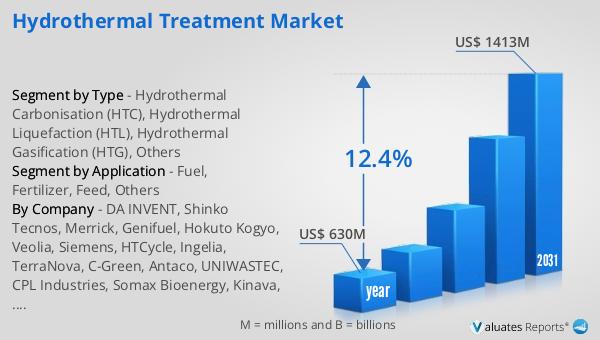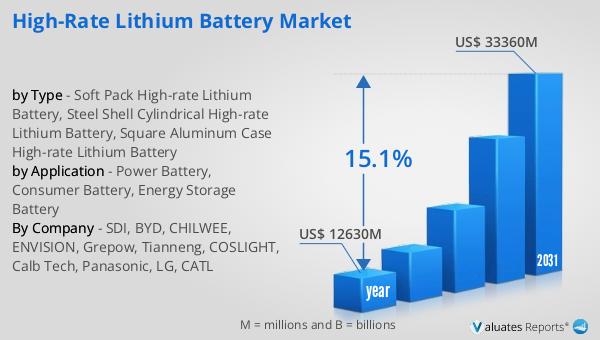What is Global Hydrothermal Treatment Market?
The Global Hydrothermal Treatment Market is a rapidly evolving sector that focuses on the conversion of biomass into valuable products through the application of heat and pressure in a water-based environment. This market is gaining traction due to its potential to transform waste materials into renewable energy sources and other useful products, thereby contributing to sustainability and waste reduction efforts. Hydrothermal treatment processes are particularly appealing because they can handle wet biomass without the need for drying, which is often a costly and energy-intensive step in other biomass conversion technologies. The market encompasses various technologies such as Hydrothermal Carbonisation (HTC), Hydrothermal Liquefaction (HTL), and Hydrothermal Gasification (HTG), each offering unique benefits and applications. These processes are being increasingly adopted across different industries, including energy, agriculture, and waste management, due to their efficiency and environmental benefits. As the world continues to seek sustainable solutions to energy and waste challenges, the Global Hydrothermal Treatment Market is poised for significant growth, driven by technological advancements and increasing awareness of the need for sustainable practices. This market not only offers a pathway to cleaner energy but also provides opportunities for innovation in the production of biofuels, fertilizers, and other valuable products.

Hydrothermal Carbonisation (HTC), Hydrothermal Liquefaction (HTL), Hydrothermal Gasification (HTG), Others in the Global Hydrothermal Treatment Market:
Hydrothermal Carbonisation (HTC) is a process that involves the conversion of wet biomass into a coal-like substance called hydrochar. This process occurs under relatively mild temperatures and high pressures, typically in the range of 180 to 250 degrees Celsius and 2 to 10 MPa, respectively. HTC is particularly advantageous because it can process a wide variety of biomass feedstocks, including agricultural residues, food waste, and sewage sludge, without the need for drying. The resulting hydrochar is rich in carbon and can be used as a solid fuel, soil amendment, or activated carbon precursor. Hydrothermal Liquefaction (HTL), on the other hand, converts wet biomass into a liquid bio-crude oil through the application of moderate temperatures (250 to 350 degrees Celsius) and high pressures (10 to 20 MPa). This bio-crude can be further refined into transportation fuels such as gasoline, diesel, and jet fuel. HTL is particularly suited for processing algae, lignocellulosic biomass, and other high-moisture feedstocks, offering a promising pathway for the production of renewable fuels. Hydrothermal Gasification (HTG) involves the conversion of wet biomass into syngas, a mixture of hydrogen, carbon monoxide, and methane, through the application of high temperatures (above 374 degrees Celsius) and pressures (above 22 MPa). This process is highly efficient and can convert nearly all the organic material into gas, making it an attractive option for waste-to-energy applications. HTG is particularly useful for processing wet organic waste, such as municipal solid waste and industrial effluents, providing a sustainable solution for waste management and energy production. Other hydrothermal treatment processes include Hydrothermal Oxidation and Hydrothermal Reforming, which offer additional pathways for converting biomass into valuable products. Hydrothermal Oxidation involves the oxidation of organic materials in water at high temperatures and pressures, resulting in the production of carbon dioxide, water, and heat. This process is particularly effective for the treatment of hazardous waste and the recovery of energy from organic waste streams. Hydrothermal Reforming, on the other hand, involves the conversion of biomass into hydrogen-rich gas through the application of heat and pressure in the presence of a catalyst. This process offers a promising pathway for the production of renewable hydrogen, which is increasingly being recognized as a key component of the future energy landscape. Overall, the Global Hydrothermal Treatment Market encompasses a diverse range of technologies, each offering unique benefits and applications. These processes are being increasingly adopted across different industries, driven by the need for sustainable solutions to energy and waste challenges. As the market continues to evolve, it is expected to play a critical role in the transition towards a more sustainable and circular economy.
Fuel, Fertilizer, Feed, Others in the Global Hydrothermal Treatment Market:
The Global Hydrothermal Treatment Market finds applications in various areas, including fuel, fertilizer, feed, and others, each offering unique benefits and opportunities. In the fuel sector, hydrothermal treatment processes such as Hydrothermal Liquefaction (HTL) and Hydrothermal Gasification (HTG) are particularly significant. HTL converts wet biomass into bio-crude oil, which can be further refined into transportation fuels like gasoline, diesel, and jet fuel. This process offers a sustainable alternative to fossil fuels, reducing greenhouse gas emissions and dependence on non-renewable resources. HTG, on the other hand, produces syngas, a versatile energy carrier that can be used for electricity generation, heating, and as a feedstock for chemical synthesis. The ability to convert wet biomass into valuable fuels without the need for drying makes hydrothermal treatment an attractive option for the production of renewable energy. In the fertilizer sector, Hydrothermal Carbonisation (HTC) plays a crucial role. The hydrochar produced through HTC is rich in carbon and nutrients, making it an excellent soil amendment and fertilizer. It improves soil structure, enhances nutrient retention, and increases water-holding capacity, leading to improved crop yields and soil health. The use of hydrochar as a fertilizer also contributes to carbon sequestration, helping to mitigate climate change. In the feed sector, hydrothermal treatment processes can be used to convert agricultural residues and food waste into high-quality animal feed. The treatment process breaks down complex organic materials into simpler compounds, making them more digestible and nutritious for livestock. This not only provides a sustainable solution for waste management but also reduces the reliance on conventional feed sources, which are often associated with environmental and ethical concerns. Other applications of the Global Hydrothermal Treatment Market include the production of bio-based chemicals, materials, and energy carriers. Hydrothermal processes can be used to produce a wide range of chemicals, including organic acids, alcohols, and hydrocarbons, which can serve as building blocks for the chemical industry. These processes also offer opportunities for the production of bio-based materials, such as bioplastics and bio-composites, which are increasingly being recognized as sustainable alternatives to conventional materials. Additionally, hydrothermal treatment can be used for the recovery of valuable metals and nutrients from waste streams, contributing to resource efficiency and circular economy goals. Overall, the Global Hydrothermal Treatment Market offers a diverse range of applications across different sectors, each contributing to sustainability and resource efficiency. As the market continues to grow, it is expected to play a critical role in the transition towards a more sustainable and circular economy, providing innovative solutions to energy, waste, and resource challenges.
Global Hydrothermal Treatment Market Outlook:
The global market for Hydrothermal Treatment was valued at approximately 630 million USD in 2024, and it is anticipated to expand significantly, reaching an estimated size of 1,413 million USD by 2031. This growth trajectory represents a compound annual growth rate (CAGR) of 12.4% over the forecast period. This impressive growth rate underscores the increasing recognition and adoption of hydrothermal treatment technologies across various industries. The market's expansion is driven by the growing demand for sustainable and efficient waste management solutions, as well as the need for renewable energy sources. Hydrothermal treatment processes offer a versatile and effective means of converting biomass and waste materials into valuable products, such as biofuels, fertilizers, and chemicals. As industries and governments worldwide continue to prioritize sustainability and environmental responsibility, the demand for hydrothermal treatment technologies is expected to rise. This market outlook highlights the significant potential for innovation and investment in the hydrothermal treatment sector, as it plays a crucial role in addressing global energy and waste challenges. The projected growth of the market reflects the increasing awareness and commitment to sustainable practices, paving the way for a cleaner and more sustainable future.
| Report Metric | Details |
| Report Name | Hydrothermal Treatment Market |
| Accounted market size in year | US$ 630 million |
| Forecasted market size in 2031 | US$ 1413 million |
| CAGR | 12.4% |
| Base Year | year |
| Forecasted years | 2025 - 2031 |
| Segment by Type |
|
| Segment by Application |
|
| By Region |
|
| By Company | DA INVENT, Shinko Tecnos, Merrick, Genifuel, Hokuto Kogyo, Veolia, Siemens, HTCycle, Ingelia, TerraNova, C-Green, Antaco, UNIWASTEC, CPL Industries, Somax Bioenergy, Kinava, EIT InnoEnergy, DBFZ |
| Forecast units | USD million in value |
| Report coverage | Revenue and volume forecast, company share, competitive landscape, growth factors and trends |
